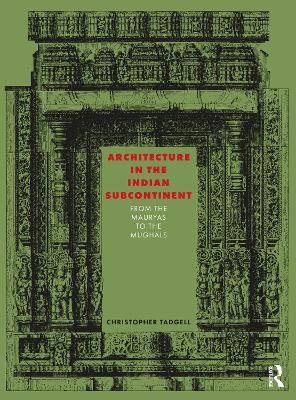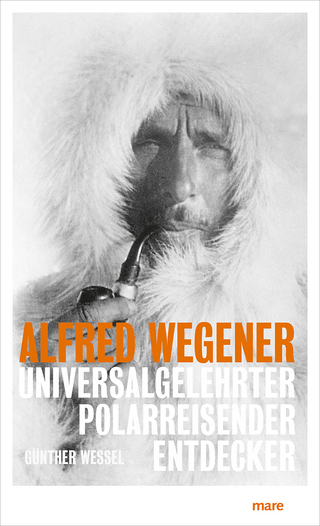
Architecture in the Indian Subcontinent
Routledge (Verlag)
978-1-032-11270-1 (ISBN)
Dedicated to the tracing of continuity across sectarian divides, Christopher Tadgell’s History of Architecture in India (1989) was the first modern monograph to draw together in one volume all the strands of India’s pre-colonial architectural history – from the Vedic and Native traditions of early India, through Hindu, Buddhist, Islamic and secular architecture. This comprehensive revision, Architecture in the Indian Subcontinent: From the Mauryas to the Mughals, expands the structure to acknowledge the great advance in scholarship across this extremely complex subject over the last three decades.
An understanding of Indian history and religion is the basis for understanding the complex pattern of relationships in the evolution of architecture in the subcontinent. Therefore, background material covers major invasions, migrations, dynastic conflicts and cultural and commercial connections, the main religious developments and their significance and repercussions, and external architectural precedents. While avoiding the usual division of the subject into ‘Buddhist and Hindu’ and ‘Islamic’ parts in order to trace continuity, the importance of religion, symbolism and myth to the development of characteristic Indian architectural forms in all their richness and complexity is fully explained in this fully illustrated account of the subcontinent’s architecture.
Christopher Tadgell studied art history at the Courtauld Institute in London and in 1974 was awarded his PhD for a thesis on the Neoclassical architectural theorist, Ange-Jacques Gabriel. He subsequently taught in London and at the Kent Institute of Art and Design in Canterbury, with interludes as F.L. Morgan Professor of Architectural Design at the University of Louisville and as a Member of the Institute for Advanced Study at Princeton. Now extensively revised and updated, his History of Architecture in India (London 1989) has been the definitive one-volume account of the architecture of the subcontinent for more than thirty years, while many publications on French architecture include most recently The Louvre and Versailles: The Evolution of the Proto-Typical Palace in the Age of Absolutism (Abingdon 2020) and the standard account in Baroque and Rococo Architecture and Decoration (ed. Blunt, London 1978). His seven-volume series Architecture in Context is an unmatched survey of the seminal architectural traditions from the earliest times to the end of the 20th century. He has contributed many articles on Indian and French architecture to The Grove Dictionary of Art and other major reference books, including the 2019 revision of Sir Banister Fletcher’s Global History of Architecture.
PROLOGUE: EARLY INDIA PART 1: 4TH CENTURY BCE-4TH CENTURY CE INTRODUCTION: FIRST EMPIRES 1.1 STUPA AND MONASTERY IN THE EARLY IMPERIAL ERA 1.1.1 ASHOKAN FOUNDATIONS 1.2 THE TRANSFORMATION OF BUDDHISM 1.2.1 MANIFESTAT ION OF TRANSFORMATION: ART AND ARCHITECTURE 1.3 THE ADVENT OF HINDUISM AND THE ESOTERIC 1.3.1 THEOLOGY AND THE INVENTION OF THE TEMPLE 1.3.2 UNITY IN VARIETY OF SYMBOLIC FORM PART 2: 4TH-13TH CENTURY CE BUDDHISM ECLIPSED; HINDUS ASCENDANT 2.1 THE EARLY TEMPLE: EXCAVATION AND BUILDING 2.2 DECCANI ECLECTICISM AND THE DRAVIDIAN MERU 2.2.1 EARLY CHALUKYAN DERIVATIONS 2.2.2 EARLY PALLAVAN REPRESENTATION 2.2.3 RETURN TO ELLORA FOR THE APOGEE OF ECUMENICAL EXCAVATION 2.2.4 THE CHOLAS AND THEIR NEIGHBOURS 2.3 ASCENT TO NAGARA MERUS: LATINA, SHEKHARI AND BHUMIJA 2.3.1 PRATIHARA FOUNDATIONS 2.3.2 SHEKHARI PROLIFERATION 2.3.3 APOTHEOSIS OF LATINAIN OR ISSA 2.3.4 THE BHUMIJA OF THE PARAMARAS AND THEIR NEIGHBOURS 2.4 VE SARA: SYNTHESES AND ABSTRACTION IN KARNATIKA 2.4.1 LATER CHALUKYAN CROSS-FERTILISATION 2.4.2 HOYSALA SYNTHESIS PART 3: 13TH-18TH CENTURY ISLAM ASCENDANT : HINDUS AND JAINS DEFENSIVE 3.1 ISLAM IN INDIA AND THE PATTERN OF MUSLIM PATRONAGE 3.2 AFGHANS , TURKS AND THEIR DELHI SULTANATE 3.3 REGIONAL GRAVITY 3.3.1 RIVALS TO THE SULTANATE IN THE SOUTH 3.3.2 SUCCESSORS TO THE SULTANATE IN THE NORTH 3.4 THE MUGHALS : ADVENT 3.5 RETURN TO THE DECCAN: QUTBSHAHIS AND ADILSHAHIS 3.6 THE MUGHALS : APOGEE EPILOGUE: HINDUSTANI SYNCRETISM
| Erscheinungsdatum | 15.12.2023 |
|---|---|
| Zusatzinfo | 298 Line drawings, color; 924 Halftones, color; 1222 Illustrations, color |
| Verlagsort | London |
| Sprache | englisch |
| Maße | 210 x 280 mm |
| Gewicht | 1619 g |
| Themenwelt | Geisteswissenschaften ► Geschichte ► Regional- / Ländergeschichte |
| Naturwissenschaften ► Biologie ► Ökologie / Naturschutz | |
| Naturwissenschaften ► Geowissenschaften ► Geografie / Kartografie | |
| Sozialwissenschaften ► Soziologie ► Spezielle Soziologien | |
| Technik ► Architektur | |
| ISBN-10 | 1-032-11270-0 / 1032112700 |
| ISBN-13 | 978-1-032-11270-1 / 9781032112701 |
| Zustand | Neuware |
| Informationen gemäß Produktsicherheitsverordnung (GPSR) | |
| Haben Sie eine Frage zum Produkt? |
aus dem Bereich


